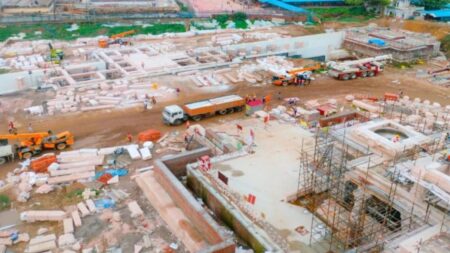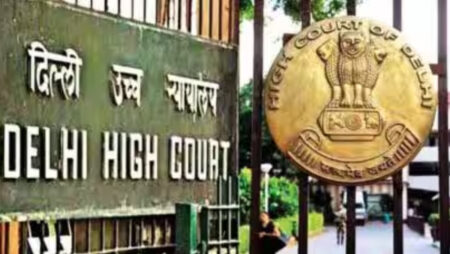The Allahabad High Court extended the stay till October 31 on a court order directing the Archaeological Survey of India to conduct a survey at the Kashi Vishwanath temple-Gyanvapi mosque complex Varanasi.
The Allahabad High Court on Wednesday extended the stay till October 31 on a Varanasi court order directing the Archaeological Survey of India to conduct a survey at the Kashi Vishwanath temple-Gyanvapi mosque complex and further proceedings in this case.
Justice Prakash Padia, after hearing the parties concerned, fixed October 18 as the next date of hearing in the case.
On August 30, the high court had extended the interim stay till September 30 on the Varanasi court’s order dated April 8, 2021.
The Anjuman Intezamia Masjid, the Gyanvapi mosque management committee of Varanasi, had filed a petition challenging the maintainability of an original suit filed in 1991 in the Varanasi district court.
The original suit sought restoration of the ancient Kashi Vishwanath Temple at the site where the Gyanvapi Mosque currently stands. The petitioners claimed in the suit that the mosque is a part of the temple.
On September 12, Justice Padia also directed the director general, ASI, to file his personal affidavit in the case within 10 days as the counter affidavit filed by ASI was very sketchy and the matter was of national importance.
Pursuant to the order dated September 12, an affidavit was filed by Abinash Mohanty, Superintending Archaeologist, ASI Varanasi, along with an application for exemption as the director general was unfit and not in position to file his personal affidavit.
However, the court observed, “Since the matter is of national importance and fact that the suit is pending before the trial court since 1991, this court hopes and trusts that the Director General, ASI, New Delhi will comply with the order dated September 12, 2022, in its letter and spirit on or before the next date fixed in the matter.
When Did The Legal Despute Began?
The Gyanvapi mosque-Kashi Vishwanath dispute first reached the courts in 1991, when a petition sought the removal of the mosque from the site and the transfer of possession of the land to the Hindu community.
The petitioners, which included the Kashi Vishwanath Mandir Trust, claimed that Maharaja Vikramaditya had built the temple more than 2,000 years ago and that the mosque was only constructed in 1664 after Mughal ruler Aurangzeb ordered the demolition of the temple.

The petitioners alleged that the Gyanvapi mosque was built on a portion of the land using the ruins of the temple, saying that remains of the old temple could still be seen adjacent to the mosque.
The legal suit coincided with the peak of the Ram Janmabhoomi-Babri Masjid issue in Ayodhya. Interestingly, the Kashi Vishwanath-Gyanvapi mosque complex featured as one of the three religious sites the Vishwa Hindu Parishad (VHP) wanted to “liberate” during the Ram Janmabhoomi movement, along with Ayodhya’s Babri Masjid and the Shahi Idgah in Mathura.
What Does The History says About Gyanvapi Mosque?
The Kashi Khanda of the Skanda Purana narrates a fascinating tale about the origin of the ‘Well of Wisdom’—Gyanvapi. According to the Puranic texts, dating back to the 5th-13th centuries CE, Ishan—a form of Shiva—had himself dug the well to cool the lingam of Vishveshvara (Vishwanath) with water. This event is said to have taken place at a time when there was no water on earth.
The water that bursts out from the well is said to be the liquid form of gyana (wisdom); enlightening wisdom, to be precise. Hence the name Gyanavapi, now commonly referred to as Gyanvapi.

The ancient text tells us that the sacred well was dug in Kashi long before the river Ganga came to Earth. Considered to be the most sacred water pool on Earth, the Gyanvapi well is also called the Shivatirtha, Gyanodatirtha, Tarakatirtha and Mokshatirtha. Two chapters of the Kashi Khanda are dedicated entirely to eulogise Gyanvapi and its power to drive away evil spirits and cleanse the sins of devotees.
Will Gyanvapi Set Off Another Ayodhya In India?
As the campaign to remove the Gyanvapi mosque in Varanasi gains momentum, another Ayodhya looms large over India.

It’s understandable for a civilization to carry a wound. It may be real or imagined but, unless it’s politically manipulated, it needs to be respected and addressed. Such wounds may exist beyond the letter of the Constitution, and yet a mature civilization is expected to acknowledge and resolve them.
But if one thought that the Ram temple would assuage the injured Hindu pride, it’s not to be. No other than Atal Bihari Vajpayee had once emphatically said: “Kashi and Mathura are not on our agenda, they will never be…when we are saying that it’s not on our agenda, you need to trust us…hum Ayodhya ki punaravritti nahin hone denge, yah hum bilkul saaf baat kahna chahte hain. (We will not let another Ayodhya happen. We want to state it clearly).













